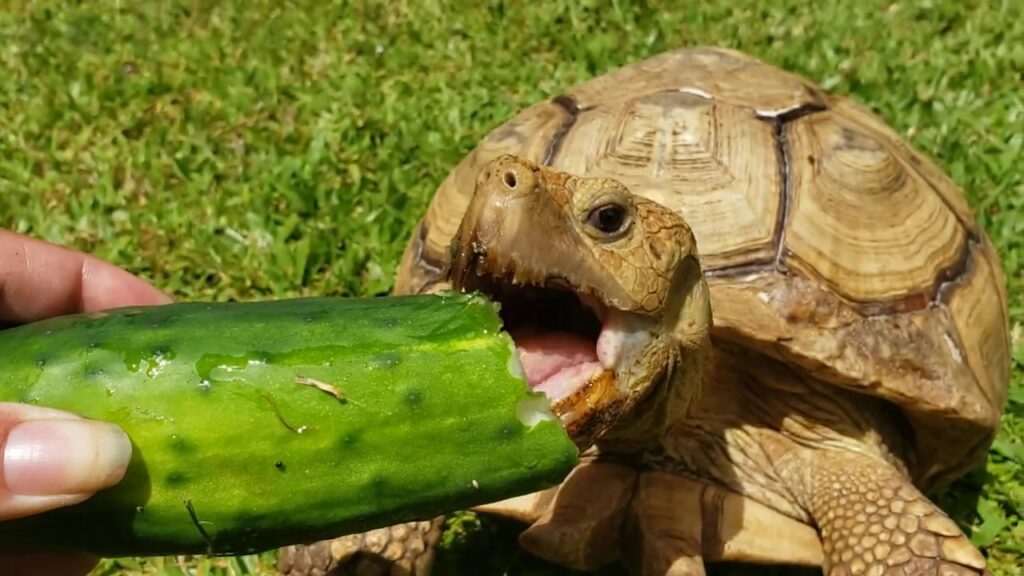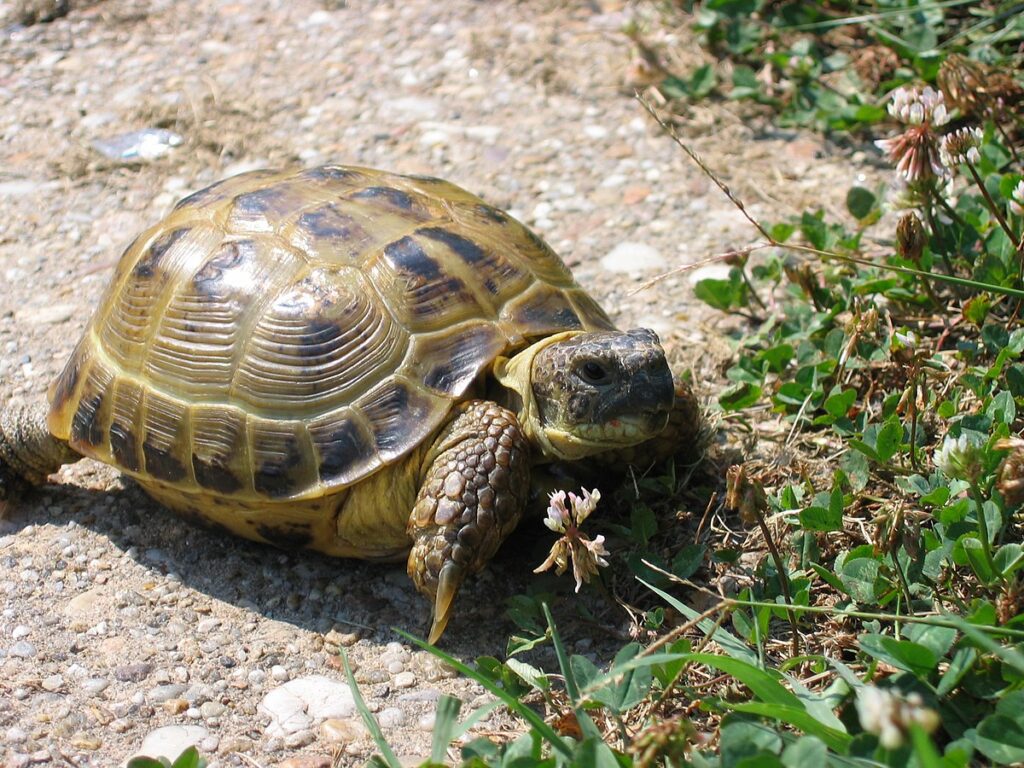Table of Contents
ToggleIntroduction

Russian Tortoises, scientifically known as Agrionemys horsfieldii, are petite and charming tortoises that hail from the arid regions of Central Asia. Can Russian Tortoises Eat Cucumbers? Their small size, resilient nature, and distinct appearance make them popular among reptile enthusiasts and pet owners. These tortoises are by their high-domed carapace, which protects against predators and environmental hazards.
These delightful creatures have earned a reputation for their gentle temperament and intriguing behaviours. While they may not be as interactive as other pets, they exhibit unique traits that endear them to their owners. Russian Tortoises are known for their burrowing tendencies, an adaptation to their native, harsh environment. They often dig shallow burrows to escape extreme temperatures, both heat and cold, which reflects their adaptability in captivity.
Natural Habitat And Diet In The Wild
Russian Tortoises (Agrionemys horsfieldii) are native to the arid regions of Central Asia. Including countries like Russia, Kazakhstan, Pakistan, and Iran. Their natural habitat encompasses semi-desert and grassland environments, where they have adapted to survive in harsh and often arid conditions.
In the wild, Russian Tortoises primarily feed on various plants, grasses, and flowers native to their arid ecosystems. Their diet consists of low-growing vegetation, which includes a diverse array of herbaceous plants such as dandelions, clover, plantain, and other wild greens. These tortoises are opportunistic feeders, and their diet varies based on the plant availability in their immediate environment. This diverse diet ensures that they receive a range of essential nutrients. Including dietary fibre, vitamins, and minerals, while also helping to maintain proper hydration levels.
Their natural habitat features a diet high in fibre and low in protein and fat, an essential adaptation to their environment. Russian Tortoises are well-suited to digesting fibrous plant materials and equipped with a sturdy beak that allows them to graze on various vegetation.
Important Of Replicating Natural Diet In Captivity
When keeping Russian Tortoises in captivity, it is crucial to understand and replicate their natural diet to ensure their well-being and longevity. A diet that resembles what they would consume in the wild provides various benefits for these charming reptiles.
Nutritional Balance: A diet based on their natural feeding habits ensures they receive the right balance of nutrients. It helps prevent health issues related to imbalances in their diet, such as excessive protein or inadequate fibre intake.
Healthy Digestion: The fibrous and plant-based diet typical of their natural habitat promotes healthy digestion. It aids in preventing common issues like constipation or impaction, which can arise from a diet that is too high in protein or lacks adequate fibre.
Hydration: Russian Tortoises have adapted to obtain much hydration from the plants they consume. By replicating their natural diet, you help ensure they stay hydrated, even in a captive setting.
Behavioural Enrichment: Offering a diet similar to their wild counterparts provides mental and physical stimulation. Grazing and foraging are integral to their natural behaviours, and a proper diet can help satisfy these instincts.
Key Components Of Their Diet
Russian Tortoises require a diet primarily consisting of vegetables, fruits, and greens. Here are the key components of their diet:
Leafy Greens: Leafy greens are the foundation of a Russian Tortoise’s diet. Suitable greens include dandelion, collard, mustard, kale, and turnip greens. These greens are rich in fibre, vitamins, and minerals, making them essential for a balanced diet.
Fibrous Plants: Besides leafy greens, Russian Tortoises benefit from consuming fibrous plants like hibiscus leaves and flowers, opuntia (prickly pear cactus), and mulberry leaves. These fibrous options help maintain proper digestion and overall health.
Weeds and Wild Plants: Wild plants such as clover, plantain, and dandelions are excellent additions to their diet, replicating their natural foraging habits. These plants are typically readily available and can provide a varied and balanced diet for your tortoise.
Occasional Vegetables and Fruits: While the primary diet should consist of leafy greens and fibrous plants, you can offer small portions of vegetables like bell peppers, squash, and zucchini, as well as occasional fruits like strawberries or melon as treats. These should be given sparingly due to their higher water content and sugar levels.
Nutritional Content Of Cucumbers
Cucumbers (Cucumis sativus) are a popular and refreshing vegetable consumed by humans, but their nutritional content may not align perfectly with the dietary requirements of Russian Tortoises. Understanding the nutritional composition of cucumbers is essential to assess their suitability for these charming reptiles.
Cucumbers are primarily composed of water, with a high water content of approximately 95%. It makes them a hydrating and low-calorie option for humans.
However, the nutritional profile of tortoises is quite different. Cucumbers contain a small amount of other nutrients, including:
Dietary Fiber: Cucumbers provide a modest amount of dietary fibre, aiding digestion. Fibre is essential for maintaining healthy gut function and preventing constipation.
Vitamins: Cucumbers contain small amounts of vitamins such as K and C. While these vitamins are beneficial, they are not in significant quantities in cucumbers.
Minerals: Cucumbers offer minimal minerals like potassium, essential for various bodily functions but not a prominent feature of their nutritional profile.
Sugar and Protein: Cucumbers contain minimal sugar and virtually no protein, aligning with their low-calorie, water-rich vegetable role.
Water Content And Its Implications For Tortoises
The high water content in cucumbers is a significant factor when offering them to Russian Tortoises. While hydration is essential for all living beings, including tortoises, Russian Tortoises develop a way to obtain most of their water from the vegetation they consume in their natural habitat. Therefore, a diet with an excessively high water content, like cucumbers, may disrupt the balance of nutrients in their diet and potentially lead to dehydration if offered in large quantities.
Cucumbers may not provide the necessary dietary fibre and nutrients that Russian Tortoises require. The high water content can dilute the nutrients in their diet, potentially leading to malnutrition if cucumbers become a staple food. Tortoises need fibre-rich, low-protein foods to maintain proper digestive health and well-being.
Conclusion
With their endearing and resilient nature, Russian tortoises thrive when their diet closely mirrors the fibrous and plant-based foods they consume in their native arid habitats. While cucumbers are generally safe for these delightful reptiles when given in moderation, they should not be a staple or a primary component of their diet.
Understanding the nutritional content of cucumbers is crucial when considering them as part of a Russian Tortoise’s menu. Cucumbers are primarily composed of water, with a low nutritional value for these tortoises. Their high water content, while beneficial for humans in terms of hydration, can pose challenges for Russian Tortoises, who obtain most of their water from the vegetation they consume.







